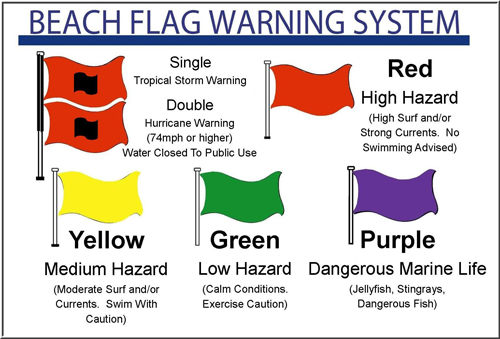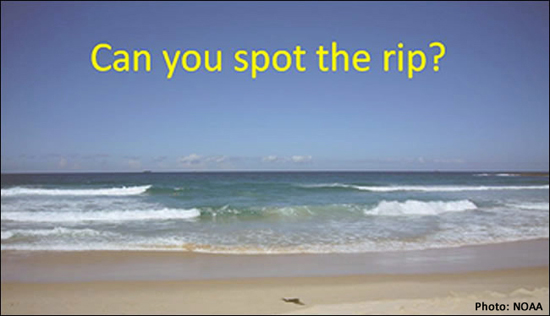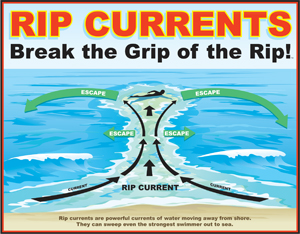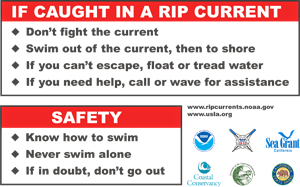Return to Flotilla 20-4's Home Page.
First - Know How To Swim. You should be a strong swimmer before you go into the ocean. Swim where lifeguards are on duty. Always obey all lifeguard orders and instructions. Never swim alone.
Know the local weather forecast before you go to the beach. Click on the following links to search for Weather and Surf Zone Forecasts from the National Weather Service, some important science about climate, hurricanes and more from NOAA - National Oceanic and Atmospheric Administration:
National Weather Service - NOAA
National Weather Service Surf Zone Forecast
Beach Advisory and Closing On-line Notification
In the United States, including Puerto Rico, Guam, and the Virgin Islands, HEAT is the number one weather related cause of fatalities, injuries and damages. The second leading weather related cause is FLOODING. Click on the following link for NOAA Weather Related Hazard Statistics
Know what hazards you may encounter
before you go to the beach.
Know how you can keep safe from those hazards so you can have fun and
enjoy your time while you're there.

Know what the warning flags mean. Not all beaches have flags. Read and obey the posted beach warning signs and flags you may see. Knowing these things and taking the few moments of time to do this can make all the difference for your safety while you are at the beach. Learn more from NOAA's National Ocean Service and mitigate the risks to stay safe: Ten Dangers at the Beach
Know the water quality status before you go swimming. Sound Rivers updates the monitored sample results for water quality conditions of the Tar-Pamlico and Neuse River Watersheds from a number of Swim Guide sites. Click on the following link to view their most recent water quality status updates: Swim Guide
Know that cold water can be dangerous. Know how you can help protect yourself. Be safe from cold water hazards: Cold Water Hazards and Safety
Know that extreme heat exposure can be dangerous. Know how you can recognize the signs and symptoms of extreme heat related illness and the appropriate responses and first aid measures needed - Stay Weather Ready: weather.gov/safety/heat-illness
Know How Incidents Involving Rip Currents Can Be Prevented.

A Rip Current will Not pull you under the water and is Not "undertow".
A Rip Current is Not a "riptide", as it is
Not A Tide.
WATCH THIS IMPORTANT VIDEO FROM NOAA:
Rip currents are complex, can be dangerous, powerful, fast moving and they can occur at any beach which has breaking waves. Rip currents need breaking waves to form and there are many different kinds of rip currents. Don't place yourself in harms way. Lack of skills to identify rip currents is a major safety concern. Knowledge is power that can help you take control of the situation to make the best decisions for your safety. When people are able to recognize the signs of an operating rip current they can avoid that area in the water. Surfers will often use rip currents to help them paddle their surfboards faster. They recognize the channel or "dip" and darker water color traveling in between where waves are breaking, noticing Where Waves are Not Breaking. Surfers have a saying, "Where there's a dip, there's a rip." Click on the following link for some more information from NOAA Ocean Today: Rip Current Science
Know what to do if you see someone who is caught in a rip current. The best thing you can do for them is to throw them some form of flotation for them to hold onto and keep them afloat, while you inform a life guard and get help.
Know what to do if you find yourself caught in a rip current - Do Not try to swim against the flow of a rip current. Doing so will exhaust your energy - Not a survival option. The best way you can be safe is to be calm, conserve your energy by floating with the flow of the current and know it will eventually slow down and stop flowing. Signal Wave Your Arm While Calling For Help and Think to assess the situation, your surroundings and what your best options may be. If you have enough energy and you feel able, your best option may be to swim to either side and out of the rip current by swimming parallel to the land/the shore. (Refer to the Break the Grip of the Rip image posted below) Once you are out of the rip current, then swim toward the shore. Recognize that you could possibly get caught in another rip current along your way swimming back to shore. Be aware that rip currents can carry you quite a far distance away from the shore in a relatively short period of time. Your Situational Awareness Is Important!
Panic and fatigue from trying to
fight a rip are the cause of tragedy. Your body may have a panic response, because it can be a scary experience. Fear is Not Your Friend In A Rip Current. You can be caught in a rip current and not realize it until you find yourself being pulled away from the beach, while struggling to swim causes you fatigue and you're not getting any closer to the shore. If this happens to you, try not to panic, just float and conserve your energy. The best approach to take to keep
you safe, is one which eliminates panic. Even the very fit and best of
swimmers can find themselves in trouble, if panic and fatigue take control.


"Anyone Can Drown, No One Should."
The signs that a person in the water is drowning are often missed, before they go under water. A drowning victim doesn't look like what you see in the movies and on television. When a person is drowning, they go silent, becoming unable to call for help and unable to move their arms to properly reach for a flotation device.
The following is a link to an important article by retired U.S. Coast Guard Chief Warrant Officer 2 Mario Vittone: "Drowning Doesn't Look Like Drowning"
Some of the signs to be aware of when a person in the water is drowning:
- Head low in the water, mouth at water level
- Hyperventilating or gasping
- Eyes glassy and empty, unable to focus
- Eyes are closed
- Hair over forehead or eyes
- Trying to roll over on the back
- Not using legs - vertical
- Appear to be climbing an invisible ladder
- Trying to swim in a particular direction without making headway
Be Deliberately Aware Of Your Trash and
Do The Right Thing With It.
Marine Debris is a significant threat to our marine safety and the environment. National Oceanic Atmospheric Administration (NOAA) Marine Debris Program Office of Response and Restoration: https://marinedebris.noaa.gov/.